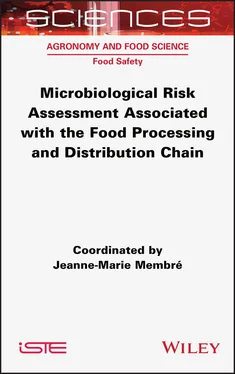1 Cover
2 Title Page SCIENCES Agronomy and Food Science , Field Directors – Jack Legrand and Gilles Trystram Food Safety , Subject Head – Jeanne-Marie Membré and Thierry Bénézech
3 Copyright First published 2022 in Great Britain and the United States by ISTE Ltd and John Wiley & Sons, Inc. Apart from any fair dealing for the purposes of research or private study, or criticism or review, as permitted under the Copyright, Designs and Patents Act 1988, this publication may only be reproduced, stored or transmitted, in any form or by any means, with the prior permission in writing of the publishers, or in the case of reprographic reproduction in accordance with the terms and licenses issued by the CLA. Enquiries concerning reproduction outside these terms should be sent to the publishers at the undermentioned address: ISTE Ltd 27-37 St George’s Road London SW19 4EU UK www.iste.co.uk John Wiley & Sons, Inc. 111 River Street Hoboken, NJ 07030 USA www.wiley.com © ISTE Ltd 2022 The rights of Jeanne-Marie Membré to be identified as the author of this work have been asserted by her in accordance with the Copyright, Designs and Patents Act 1988. Any opinions, findings, and conclusions or recommendations expressed in this material are those of the author(s), contributor(s) or editor(s) and do not necessarily reflect the views of ISTE Group. Library of Congress Control Number: 2021952704 British Library Cataloguing-in-Publication Data A CIP record for this book is available from the British Library ISBN 978-1-78945-084-2 ERC code: Applied Life Sciences, Biotechnology, and Molecular and Biosystems Engineering LS9_5 Food sciences (including food technology, food safety, nutrition) LS9_8 Biohazards (including biological containment, biosafety, biosecurity)
4 Preface
5 Acknowledgements
6 Introduction
Norovirus Norovirus One of the most common causes of gastroenteritis in humans worldwide is human norovirus, and specifically genogroup 2 noroviruses. Symptoms include diarrhea, vomiting (including projectile vomiting) and stomach pains. The virus can be transmitted to humans through the ingestion of contaminated food or water and directly from person to person, leading to infection in a relatively large proportion of those exposed. Estimates by the WHO Foodborne Disease Burden Epidemiology Reference Group (FERG) show that, worldwide, norovirus is linked to about 20% of all foodborne illnesses caused by diarrheal disease hazards (125 million per year). It is the most common cause of diarrheal disease for all ages and in all risk groups, with the most serious outcomes being seen in young children and the elderly. Norovirus infection is the sixth leading cause of diarrheal death in children under 5 and the second leading cause of diarrheal death in children over 5, with similar trends in all regions of the world. According to a study by ANSES (2018), in France, over the period 2006–2015, the main foods associated with outbreaks of collective food toxi-infections related to norovirus were mollusks (72%) and, in particular, oysters (usually consumed raw in France). Composite dishes were implicated in 10% of norovirus outbreaks. The other food categories (meat, fish, vegetables and egg products) were of equal significance and accounted for a total of 18% of outbreaks.
Campylobacter spp. Campylobacter spp. Campylobacter spp. are a major cause of foodborne diarrheal disease. Infection with Campylobacter is usually acquired by consuming contaminated foods such as undercooked poultry and raw milk; contaminated broiler meat is considered the most significant source of this hazard to humans. According to a study by ANSES (2018), in France, over the period 2006–2015, the main food categories identified at the time of Campylobacter outbreaks were meats (67%) and composite dishes (18%). Poultry was implicated in 71% of the outbreaks caused by meat. The composite dishes were basically sandwiches, mixed salads and ready-cooked meals. Eggs and egg products, milk and milk products and water accounted for a total of 9% of outbreaks. Death from campylobacteriosis is rare and is usually limited to very young or elderly patients or those suffering from another serious illness such as AIDS. Complications such as bacteremia, hepatitis, pancreatitis and miscarriage have all been reported with varying frequency. Post-infection complications can include reactive arthritis, which can last for several months, and neurological disorders such as Guillain–Barré syndrome, a form of paralysis that can lead to severe respiratory and neurological dysfunction or death in a few cases. According to the FERG, in 2010, Campylobacter spp. foodborne illnesses were responsible for more than 95 million cases of disease and just over 21,000 deaths worldwide. Since 2005, campylobacteriosis has been the most frequently reported foodborne illness in the European Union, with more than 236,000 confirmed cases in 2014. However, it should be noted that the growing trend in the incidence of campylobacteriosis in recent years is partly due to the improvement of surveillance and diagnostic systems in a number of European Union Member States. Prevention consists of control measures at all stages of the food chain in order to reduce transmission, from the environment to farms, through enhanced biosecurity, appropriate wastewater and fecal disposal systems, hygienic slaughter and the application of good food-handling practices, in particular avoiding cross-contamination and ensuring proper heat treatment of poultry products.
Non-typhoid Salmonella spp. Non-typhoid Salmonella spp. Non-typhoid Salmonella spp. are generally transmitted to humans through contaminated foods, usually of animal origin, such as eggs, pork and poultry, and dairy products; however, other foods, especially fresh produce, may also be involved in their transmission. Typhoid Salmonella spp. generally cause gastroenteritis characterized by the acute onset of fever, abdominal pain, diarrhea, nausea and sometimes vomiting. Infection with Salmonella spp. can, however, cause disease, especially in children, the elderly and the immuno-compromised, and can lead to post-infection complications such as reactive arthritis. In the case of invasive Salmonella spp., a number of organs and systems can be affected, resulting in bacteremia, meningitis, osteomyelitis or septic arthritis and sometimes even death. According to FERG estimates, non-typhoidal Salmonella spp. are the foodborne hazards responsible for the highest annual burden and the greatest number of deaths both globally and in the European region. Globally, according to FERG estimates, non-typhoid Salmonella spp. are responsible for approximately 78 million cases of disease and 59,000 deaths per year. In Europe, non-typhoid Salmonella spp. hold the number one place in terms of deaths due to food risks. For example, in 2014, there were over 85,000 cases of salmonellosis and 65 deaths. The two most frequently reported Salmonella serovars in the European Union are S . enteritidis and S . typhi. The European Food Safety Authority has estimated that the overall economic burden of human salmonellosis could reach €3 billion per year. According to a study by ANSES (2018), in France, over the period 2006–2015, the foods identified at the origin of outbreaks were in 40–45% of cases related to eggs or egg-based preparations. Meats were implicated in around 30% of outbreaks. Milk and dairy products represented only 9% of outbreaks from a suspected or confirmed food, but 19% of outbreaks from a confirmed food. Composite dishes (ready-cooked meals made from multiple ingredients such as couscous, lasagna, pizza, tartiflette) and fishery products were, in total, linked to slightly over 5% of salmonella outbreaks.
Читать дальше












